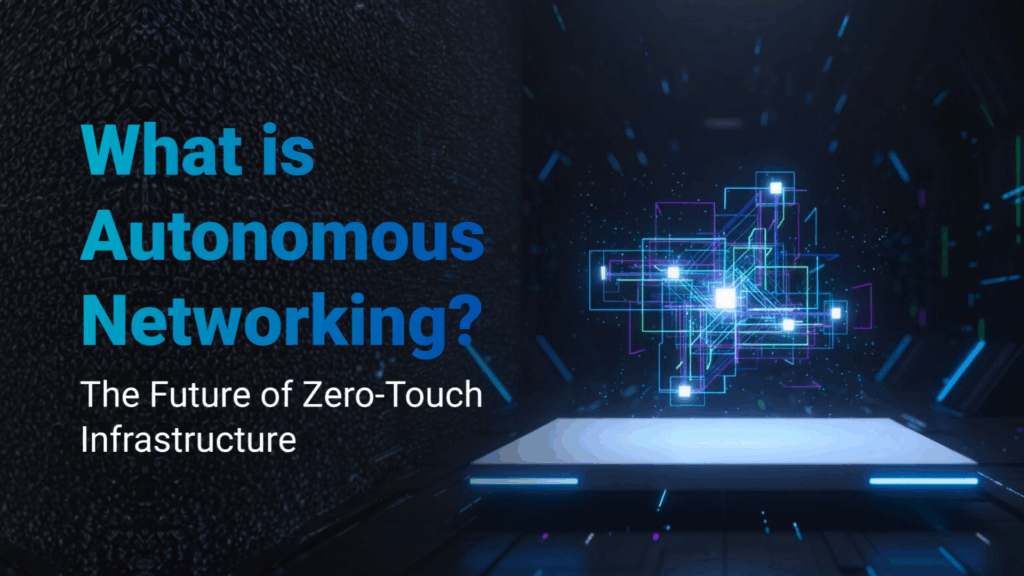
Imagine a network that doesn’t just connect devices but actually thinks. A network that detects a security breach and isolates it before a human admin opens their laptop. A network that predicts a traffic spike at 2:00 AM and re-allocates bandwidth automatically.
This isn’t science fiction—it is the reality of 自主网络. As we race toward 2025, the era of manual configuration is ending. We are entering the age of Zero-Touch Infrastructure, where Artificial Intelligence (AI) and Machine Learning (ML) take the wheel, transforming IT operations from reactive firefighting to proactive innovation.
In this guide, we’ll break down what autonomous networking is, why “zero-touch” is the Holy Grail of IT, and what the future holds for your infrastructure.
What is Autonomous Networking?
自主网络 refers to a network’s ability to run with minimal to no human intervention. Unlike traditional automation (which executes pre-written scripts), autonomous networks use AI and ML to learn from data, adapt to changes, and make decisions in real-time.
Think of the difference between cruise control and a self-driving car:
- Automation (Cruise Control): Maintains a set speed but requires a driver to steer and brake.
- Autonomy (Self-Driving): Navigates traffic, adjusts for weather, and reaches the destination without human input.
The Core Concept: Zero-Touch Infrastructure
At the heart of this revolution is Zero-Touch Infrastructure. This paradigm allows IT teams to deploy, configure, and manage thousands of devices without physically touching them or manually typing Command Line Interface (CLI) commands.
How Does It Work? The 3 Pillars
To achieve true autonomy, networks rely on three foundational technologies:
1. Intent-Based Networking (IBN)
Instead of telling the network how to do something (e.g., “configure VLAN 10 on port 2”), you tell it what you want (e.g., “Prioritize Zoom traffic for the sales team”). The network translates this business intent into technical configurations automatically.
2. AIOps (Artificial Intelligence for IT Operations)
AIOps uses big data and machine learning to analyze massive amounts of telemetry data. It establishes a “baseline” of normal behavior and instantly flags anomalies—often predicting hardware failures before they happen.
3. Closed-Loop Automation
This is the “self-healing” mechanism. If the network detects performance degradation, it automatically applies a fix (like rerouting traffic) and verifies that the issue is resolved—closing the loop without human assistance.
Why Enterprises Are Switching to Zero-Touch
The shift to autonomous infrastructure isn’t just about cool tech; it’s about survival in a complex digital world.
- 🚀 Unmatched Speed & Agility: Deploy new sites or services in minutes, not weeks. Zero-touch provisioning (ZTP) allows devices to “phone home” and configure themselves the moment they are plugged in.
- 🛡️ Enhanced Security: Human error causes the majority of network breaches. Autonomous networks eliminate manual misconfigurations and enforce security policies consistently across the entire infrastructure (Zero Trust).
- 💰 Cost Efficiency: By reducing the need for manual maintenance and site visits, operational expenses (OpEx) drop significantly. IT talent can focus on strategy rather than “keeping the lights on.”
- ⚡ 99.999% Reliability: Self-healing capabilities mean the network resolves issues faster than a human could even receive the alert, drastically reducing downtime.
The Future: Trends to Watch in 2025
As we look ahead, three major trends will define the next generation of infrastructure:
1. “Agentic” AI in Networking
By 2025, we will move beyond simple chatbots to “AI Agents” that can autonomously negotiate resources between different networks (e.g., between a private 5G network and a public cloud) to optimize for cost and latency.
2. The Rise of 6G and Edge Autonomy
As 6G research accelerates, the complexity will exceed human management capabilities. Zero-touch will become mandatory, not optional, specifically at the “Edge” (IoT devices, factory floors), where latency must be near-zero.
3. Sustainability-Driven Autonomy
Future networks will be “Green by Design.” Autonomous systems will dynamically power down unused parts of the infrastructure during low-traffic periods (like nights and weekends) to meet ESG (Environmental, Social, and Governance) goals.
Summary: The Path to Autonomy
| Level | Description | Human Involvement |
| Level 0 | Manual Management | 100% (CLI, Manual scripts) |
| Level 1 | Assisted Management | High (Dashboards, Alerts) |
| Level 2 | Partial Automation | Medium (Pre-defined scripts) |
| Level 3 | Conditional Autonomy | Low (Reviewing AI suggestions) |
| Level 4 | Zero-Touch (High Autonomy) | None (Supervisory only) |
| Level 5 | Full Autonomy | None (System is self-aware) |
Most organizations are currently at Level 2 or 3. The goal for the next five years is to reach Level 4—where the network is a silent, invisible partner in business success.
Ready to Future-Proof Your Infrastructure?
The transition to autonomous networking doesn’t happen overnight. Start by auditing your current automation tools and identifying repetitive tasks that eat up your team’s time.
